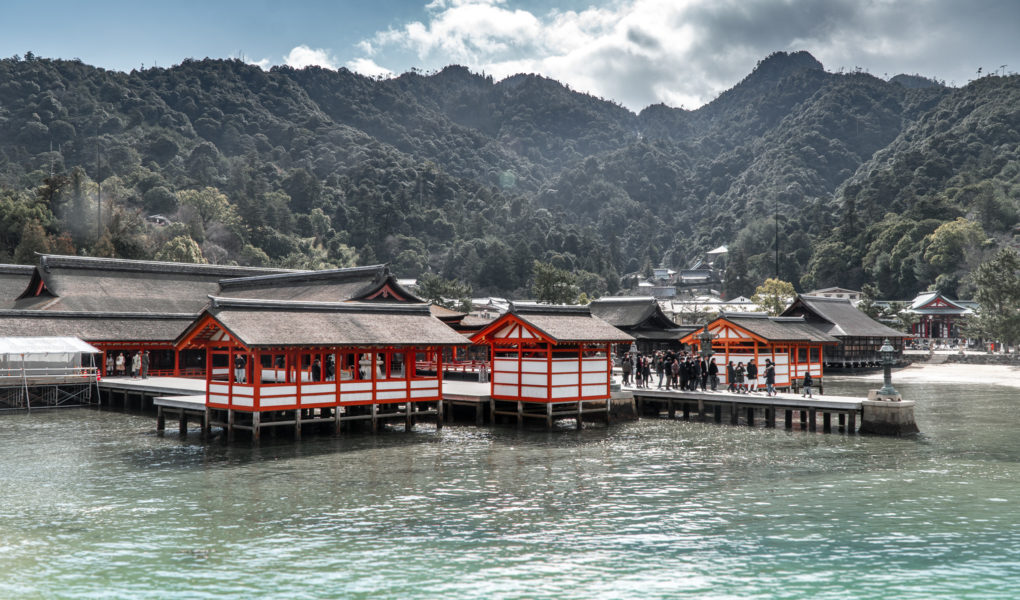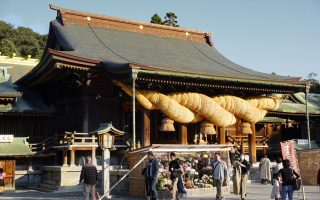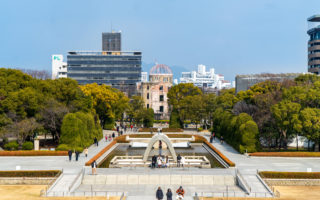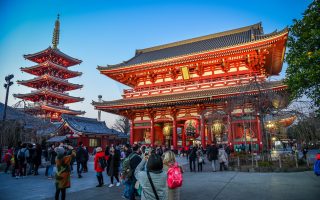Itsukushima Shrine on Miyajima island in Hiroshima Prefecture is one of the best known shrines in all of Japan, and a UNESCO world heritage site. The shrine is built in a small cove on Miyajima, and stands almost entirely over the water. The iconic torii gate located in the water in front of the shrine is known around the world.
Miyajima Hotels Hiroshima Hotels Miyajima & Hiroshima Tour Japan Rail Pass
You can already spot both the well known torii gate in the sea, and the vermilion colored columns of Itsukushima shrine as you approach the island on the ferry. The shrine seems to be floating on the water, and looks mystical as it sits there, nestled in the cove with the forest covered mountains behind it. The scene is almost too perfect to be real – like taken out of an ancient painting.
After arriving on Miyajima, a busy shopping street leads visitors in direction of the shrine. The (not so) wild deer wander the streets, hoping for tourists to feed them. A sharp turn into the cove reveals the shrine in all it’s glory. The shrine is made up of a number of separate buildings which are connected to each other by boardwalks. Everything stands on pillars in the water.
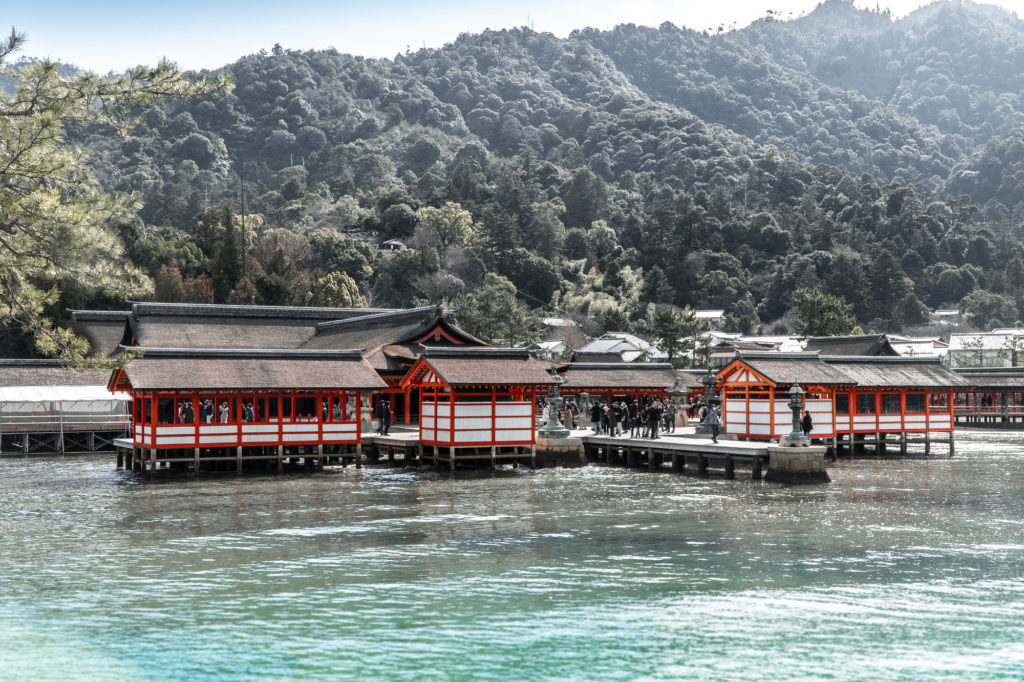
The path through the shrine is one-way, so you must pay the entrance fee and enter the shrine from the side nearest to the port. You will automatically end up at the entrance if you walk from the port, through the shopping street and along the shore.
To experience the beauty of Itsukushima Shrine to the fullest, it is best to time your visit with the tide. The shrine sits on shallow water, so the “floating” appearance is more significant during high tide. You can experience the shrine lit up at night, should you decide to spend a night on Miyajima. The island has several nice Ryokans and hotels to offer.

Photo credits (left to right): Bruno Holper (CC BY 3.0), Floyd Manyano (CC BY 2.0), Giovanni Boccardi (CC BY-SA 3.0 IGO).
Itsukushima Shrine Treasure Hall
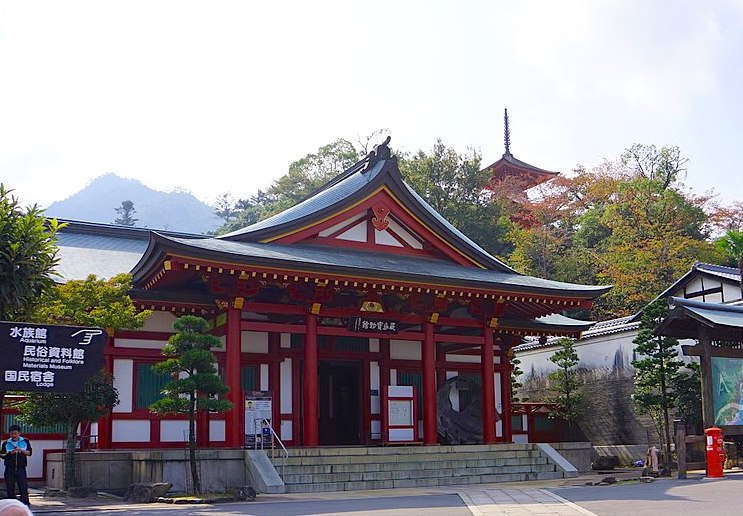
A large treasure hall is associated with Itsukushima Shrine. It is possible to enter the treasure hall between 8:00 and 17:00. A combination ticket for the shrine and the treasure hall can be purchased with a small discount at the shrine entrance.
The treasure hall of Itsukushima Shrine contains a number of historically important objects and documents relating to the shrine.
Treasure hall of Itsukushima Shrine. Photo by lienyuan lee. CC BY 3.0.
History of Itsukushima Shrine
Itsukushima (shima meaning “island“) is the official name of Miyajima island. However, people have for a long time called it Miyajima, which means “shrine island“. It’s interesting how the shrine is named after the island, and with time it seems that the island has been named after the shrine.
Miyajima has been a place of religious importance for centuries. According to the shrines own history, it was first established in the year 593 by a Saeki Kuramoto who governed the uninhabited island. The three goddesses of seafaring appeared in a dream, and he set out to build a shrine dedicated to them on the island. The shrine was likely very different from what we see today.
The shrine seen today is attributed to Taira no Kiyomori (1118-1181), a military leader and highly influential character during the Heian period (794-1185). He rebuilt it in 1168 in the shinden-zukuri architectural style commonly used for the domiciles of the high end of the society at the time. He supposedly enjoyed showing it off to friends and noble visitors.
In 1571 Mori Motonari, a prominent feudal lord, renovated the shrine and built the main hall in the style seen today.
The shrine has been used by numerous shoguns in the following centuries, and has always had an important role in the country. Miyajima has always been worshiped as a sacred place, and the island itself has even been considered to be a god. The peak of the island, the top of Mount Misen, has been considered sacred for a long time.
The religious importance of Miyajima was so big that both deaths and births were forbidden near the shrine. Even today pregnant women are expected to temporarily move off the island when they near their due date.
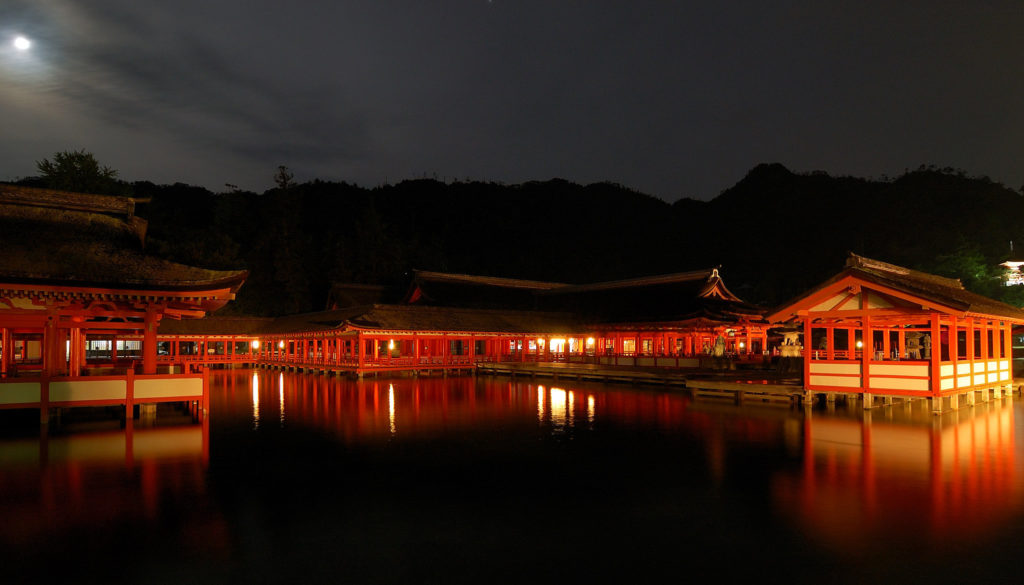
Itsukushima Shrine under the moonlight. Photo by Rosino of flickr. CC BY-SA 2.0.
Planning your visit
| Hours | 6:30 – 18:00 most days. (till 17:00 during winter) See website for details. Treasure hall: 8:00 – 17:00. |
| Entrance fee | Adult: ¥300 Highschool student: ¥200 Child: ¥100 |
| Website | Official website Tide schedule for Miyajima |
| Hotels | Kurayado Iroha ☆☆☆☆☆ Iwaso ☆☆☆☆ Sakuraya ☆☆☆ Ryoso Kawaguchi ☆☆ Miyajima Guest House Mikuniya ☆ |
Getting there
By foot: from Miyajima ferry terminal it is a 15 minute walk to the shrine entrance. Just follow either the busy shopping street, or walk along the shore.
Getting to Miyajima
By ferry: the ferry to Miyajima leaves from Miyajimaguchi port. The ferry takes 10 minutes and costs ¥180. There are two companies operating the route, Matsudai and Japan Rail. If you take the Japan Rail (JR) ferry, then the fare is covered by the Japan Rail Pass.
Train to Miyajimaguchi port: take the JR Sanyo Line from Hiroshima station to Miyajimaguchi station. The ride takes around 30 minutes and the fare is ¥420 (covered by the Japan Rail Pass). Alternatively it’s possible to take tram no.2 from Hiroshima to Miyajimaguchi. The fare is lower at ¥270, but the tram takes around 70 minutes from Hiroshima Station to Miyajimaguchi. From the station, there is a 5 minute walk to the ferry port.
Hiroshima direct ferry: there are direct ferries from Hiroshima to Miyajima. If you have limited time in Hiroshima, this might be the most efficient option. The direct boat leaves from Hiroshima Peace Park (show pier on map), and the ride takes about 45 minutes. The one-way fare is ¥2’200, and a return ticket is ¥4’000. There are 17 daily departures in each direction.
? Aqua Net official website (direct ferry)

